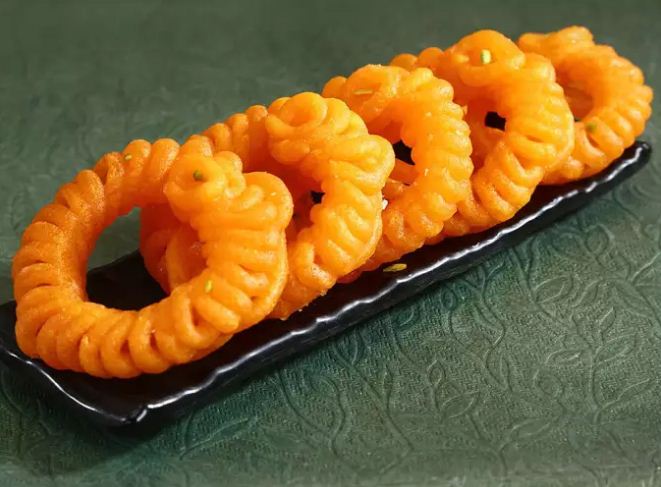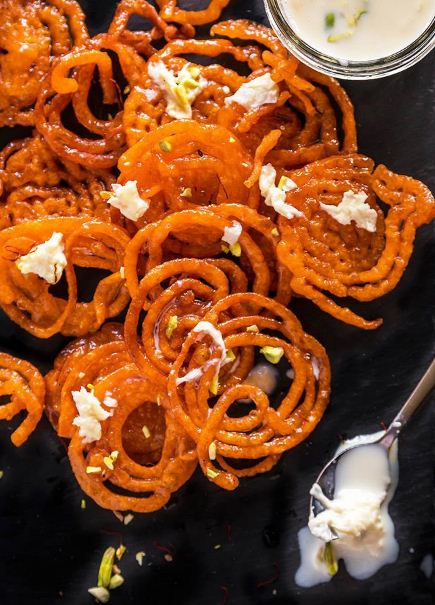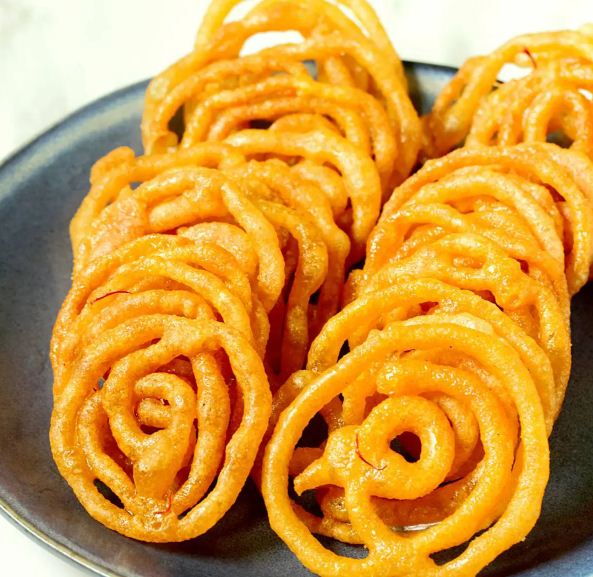By Foodie
You have grown up with the taste of hot jalebis in your mouth. You have become so used to this mouthwatering dessert delicacy that you never wondered if this was original to India. It is not, it possibly came to India from Persia (today’s Iran), or even Africa (see history), but how does that stop you from enjoying a lovely, crispy, sweet bite?
The delicacy, in fact is popular not only in India, but across south and west Asia, Africa, and Mauritius. It goes by many names, including jilapi, jilebi, jilipi, zulbia, jerry, mushabak, z’labia, or zalabia.
Jalebi still remains a very popular breakfast dish in North India. It has spread to other parts of the country too, especially in east India, where it is also known as jilipi, like in some other parts of Asia. The delicacy is too sweet, sure, and while children love to have loads of it, as you grow older, you only taste it in bits and pieces. But taste it you must. It is distributed during festivals and special occasions, with or without garnishing or a side dish.
This is a very simple dish, actually. The south Asian variety is made by deep-frying maida flour (plain flour or all-purpose flour) batter in pretzel or circular shapes, which are then soaked in sugar syrup. Jalebi is eaten with curd or rabri (in North India) along with optional other flavors such as kewra (scented water).


In some west Asian cuisines, jalebi may consist of yeast dough fried and then dipped in syrup of honey and rose water. The North African dish of Zalabia uses a different batter and syrup of honey and rose water.
Jalebi can be served warm or cold. They have a somewhat chewy texture with a crystallized sugary exterior coating. Citric acid, lime juice and rose water are sometimes added to the syrup. Similar but distinct dishes include imarti, chhena jalebi, lokma, zalabiyeh, and bamiyeh.
Recipe
Preparation Time: 24 hours 10 minutes
Cooking Time: 25 minutes
Ingredients For Batter:
- 1/2 cup Maida/All Purpose Flour
- 1 tablespoon Corn Flour (white corn starch) or Aararoot Powder
- 1/4 teaspoon Baking Powder
- A pinch of Turmeric Powder (to get yellow color)
- 1/4 cup Curd (yogurt)
- 1/4 cup Water
- Ingredients For Syrup:
- 1/2 cup Sugar
- 1/4 cup + 2 tablespoons Water
- 1 teaspoon Lemon Juice
- A pinch of Cardamom Powder (elayachi)
- 5-7 strands of Saffron (kesar), optional
NUTRITION
Calories: 324kcal
Carbohydrates: 75g
Protein: 4g
Cholesterol: 1mg
Sodium: 11mg
Potassium: 97mg
Fiber: 1g
Sugar: 50g
Vitamin A: 15mg
Vitamin C: 0.2mg
Calcium: 34mg
Iron: 1.5mg
How to make - In a large bowl mix together flour (maida), chickpea flour (besan), baking powder and baking soda.
- 1.Add yogurt, cardamom powder and mix
- 2.Add food color (if using) and water to form a flowing consistency batter.
- 3.The batter should not be too thick or thin. You may need up to 3/4 water depending on the quality of maida and besan.
- 4.Cover the batter and let the batter sit for 10-12 hours to ferment. Mine took 24 hours because I live in a cold place. You see small bubbles on top of the batter once it has fermented.
- 5.In the morning, whisk the batter a little. You may need to add little water [around 1 tablespoon] if the batter looks too thick at this point.
- 6.Meanwhile add sugar to a pan. Add water and mix with sugar and let it all come to a boil.
- 7.Once it comes to a boil, add cardamom powder, saffron strand and lemon juice.
- 8.Let it simmer till syrup becomes sticky and form a one string consistency. Basically place a drop of syrup in between your thumb and index finger and then when you move fingers away from each other, it should form a single thread.
- 9.If you can’t get consistency, just make it sticky. Keep the syrup warm while you make the jalebis.
- 10.Transfer jalebi batter into a squeeze bottle. The one I used had a very small tip hence the thin jalebis.
- 11.Meanwhile, heat oil or ghee in a pan or kadai. I used a combination of the two. Keep heat to medium-low.
- 12.Squeeze batter in hot oil, making spiral motion from inside to outside. Remember to keep at low heat else you won’t be able to form the shape. If the batter is dispersing in the oil, maybe it’s too thin and you need to add some flour to it. Once you have made the spiral shape with the batter, increase the heat to medium-high.
- 13.Fry till crisp from both sides. Remove from oil and immediately dip in warm sugar syrup, a few seconds on each side is good enough.
- 14.Remove jalebis from the sugar syrup and transfer to a serving plate. Enjoy homemade jalebi with milk or rabri. You may garnish with some nuts on top
Varieties of Jalebi:
IMARTI (Amriti in eastern India)
A popular Indian sweet, Imarti is also known as Jaangiri and belongs to Rajasthan. A circular shaped dessert, Imarti is served both cold and warm. It has quite a similar taste and cooking method to the famous Jalebi.


You can cook this delightful, bright sweet dish at home with simple ingredients and within an hour. Prepare this imarti recipe at home and serve on festive occasions like Diwali and as a good alternative to usual desserts for dinner parties.
- Ingredients
- -Split Black Gram 1 cup
- -Rice Flour
- -Rice 1/4 cup
- -Edible orange red colour as required
- -Sugar 5 cups
- -Saffron (kesar) a pinch
- -Rose essence 6 drops
- -Green cardamom powder 1 teaspoon
- -Olive oil to deep fry
Nutrition Info - Calories: 3800 Kcal
- Carbohydrates: 751.3 gm
- Protein: 54.2 gm
- Fat: 63.9 gm
- How to make:
- -Soak dal and rice together for about forty-five minutes. Drain and grind with the colour to a soft, spongy mixture with a coarse texture.
- -You would need about one cup of water to grind. The batter should not become too thin.
- -Boil sugar with two and a half cups of water till syrup of single-thread consistency is reached. Remove from heat and strain the syrup.
- -Add saffron, rose essence and green cardamom powder. Keep the syrup hot.
- -Heat sufficient olive oil in a shallow flat jalebi kadai (special type of wok). Take one ladle full of batter in the imarti cloth, hold tightly and press the batter through the hole into the hot oil.
- -For the traditional design, make a small circle around which make another circle and over these two make scallops in anti-clockwise direction ending at the starting point.
- -Make small batches and deep fry on both the sides till crisp and light golden brown. Drain the hot imarti and dip into the sugar syrup.
- -Let them remain immersed till they have absorbed enough syrup. Drain and place the imarti on a flat plate. Repeat this process till all the batter is used up. Serve hot.
Paneer Jalebi Recipe
Paneer Jalebi or Chhena Jalebi is an easy to make and popular Indian sweet or mithai that is crispy on the outside, juicy with a melt in mouth texture inside. This is one of the best sweet or dessert recipes that can be prepared in less than 30 minutes.
Paneer Jalebi is an amazingly delicious dish that you can make for your family and friends on special occasions and festivals. - Ingredients
- For paneer jalebi batter
- -1/2 cup Paneer cubes (tightly packed, check tips)
- -1/2 cup All-purpose flour or Maida
- -1/8 tsp Baking powder
- -1 tbsp Cornflour or Cornstarch
- -1/4 tsp Red-orange food color (I have used powder form)
- -1/4 cup + 2 to 3 tbsp Milk (Check tips)
For sugar syrup - -1 cup Sugar
- -1/2 cup Water
- -6 to 8 strands Saffron
- -2 drops Lemon juice
- -1/4 tsp Cardamom powder
Other ingredients - -Oil for frying
- -Pistachios for garnish
- How to Make Paneer Jalebi
- 1.Mix all the ingredients and make a thick batter. Use water if needed.
- 2. Beat the batter well with a whisk till it turns smooth.
- 3. Heat ghee or oil for frying.
- 4.Put the batter in the sauce bottle and make jalebi.
- 5. Remove it from the oil and soak it in the warm sugar syrup.
- 6. Garnish it with chopped nuts and serve!
HISTORY
Earliest Mentions
The oldest mention of
(jalebi) dates back to the early 10th century. An ancient Persian cookbook ‘Kitab al-Tabeekh’ by Muhammad bin Hasan al-Baghdadi mentions the recipe of the dish, describing it as the sweet traditionally distributed among the masses during Ramadan and other festivities. The dish also finds mention in another 10th-century Arabic cookbook by Ibn Sayyar al-Warraq.
Zulbiya is still popular in modern-day Iran, emerging as an indispensable dessert on the Nowruz (Persian New Year) platter. However, Zulbiya differs from the Indian jalebi in appearance, as the former has an asymmetric floral coil pattern, unlike the latter which is a series of circular coils. Additionally, the Middle-Eastern recipe mandates the use of a syrup of honey and rose water, while a simple sugar syrup fills Indian jalebi.
How it came to the subcontinent
According to the Hobson-Jobson glossary of Indian words & phrases, the term ‘jalebi’ is an Indianised derivative of Zulbiya – the recipe of which was brought to the Indian subcontinent by Persian traders, artisans and middle-eastern invaders throughout the medieval period.























